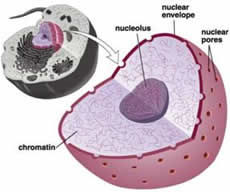Agriculture
The nucleoplasm is the protoplasm contained within the plant cell nucleus and can best be described as the fluid-filled matrix that is contained within the nuclear membrane.
The nucleoplasm is a distinct entity of the plant cell nucleus, bounded, protected, and separated from the cytoplasm by the double-membrane nuclear envelope. Connections between the cytoplasm and nucleoplasm are closely regulated by nuclear pores that penetrate the nuclear envelope at intervals.
Interiorly, these nuclear pores connect to a complex of nucleoplasmic channels that lead into the pores and serve simultaneously to direct and regulate exchange of materials between the nucleoplasm and the cytoplasm.
The nucleoplasm consists of a viscous mix of water, in which various substances and structures are dissolved or carried, and an underlying intranuclear ultrastructure.
Comparisons of the aqueous phase of nucleoplasm with that of cytoplasm using a technique called the Stokes-Einstein equation reveal that diffusion rates are 1.2 times slower through cytoplasm than nucleoplasm, indicating that nucleoplasm is a less viscous fluid than cytoplasm. Substances in the nucleoplasm include ions, enzymes, minerals, and some organic molecules and macromolecules.
The nucleoplasm is especially rich in protein enzymes and protein constituents involved in the synthesis of deoxyribonucleic acid (DNA) and the various types of ribonucleic acid (RNA), the precursor molecules of RNA, and the nucleotides from which they are assembled. Some of these proteins direct initial transcription, while others function in the further modification of the RNA molecules for packaging and transport to the cytoplasm.
Prominent structures located within the interphase nucleoplasm (the resting cell or the non replicating cell) include organelles called nucleoli and the unwound DNA, called chromatin. The nucleoli resemble miniature nuclei and are the sites of synthesis of precursor RNA molecules and their assembly.
The other major components in nucleoplasm include the DNA chromosomes seen during mitosis. During cell interphase most of the DNA chromosomes exist as unwound chromatin that extend through the nucleoplasm. Two distinct types of chromatin are recognized. Diffuse, or uncondensed, chromatin is called euchromatin and exists as thin threads that extend throughout much of the nucleoplasm.
Small sections of DNA that remain uncondensed during cell interphase are called hetero chromatin. The chromatin can be further subdivided into gene-rich R bands concentrated within the nucleus and gene-poor G bands found in the peripheral regions of the nucleus.
The space between these chromatin elements is called the inter chromatin space. Ultra structure studies have revealed a surprisingly complex structure within this inter chromatin space. It consists of several components, including a nuclear lamina, nuclear matrix, thousands of highly organized sites called foci, and nuclear speckles.
The nuclear lamina and nuclear matrix consist of protein micro filaments?fine tubular structures which apparently provide structural support for the interior of the nucleus as well as a framework for further nuclear structure and function. The lamina consists of lamin proteins that help shape and maintain the inner membrane of the nuclear envelope.
The nuclear matrix functions in pore formation and may also be continuous with the nuclear lamina in conferring an interior structure or shape to the nuclear envelope. The nuclear matrix also binds chromosomes, or parts of chromosomes, to specific sites on the inner nuclear membrane.
Foci and nuclear speckles are both involved in the production of the several types of RNA molecules manufactured by the nucleus. Foci are apparently sites that are functionally associated with gene rich chromatin. Some scientists argue, in fact, that foci are actually functional domains on active chromatin.
Whether active chromatin sites or separate entities, the foci contain protein enzymes and assembly components involved in the transcription and splicing of ribonucleo protein (RNP) molecules associated with the production of RNA precursor or sub assembly molecules.
The production of a specific RNP molecule may involve the activity of hundreds or thousands of discrete foci. Once completed, the molecular products of the foci are transported to nuclear speckles for further modification.
Nuclear speckles appear to be clusters of RNP. They are highly organized sites that are separated from other nuclear compartments by nucleoplasm. Their role and importance is still uncertain, but they are probably nuclear structures directly involved in the final assembly and modification of the various types of RNA molecules from RNP molecules supplied by the foci.
Although much of the structure and role of the nucleoplasm remains to be investigated, it is increasingly clear that the nucleoplasm has a complex ultra structure underlying and facilitating its myriad functions.
- Endomembrane System And Golgi Complex
Endomembrane System and Golgi Complex The endomembrane system is a collective term applied to all of the membranes in a cell that are either connected with or are derived from the endoplasmic reticulum (ER), including the plasma membrane but not the membranes...
- Eukaryotic Cells
Eukaryotic cells (as opposed to prokaryotic cells) have internal, membrane-bound organelles and a distinct nucleus that physically separates the genetic material of the cell from the all of the other parts of the cell. All protists, fungi, plants, and...
- Gene Regulation
Gene Regulation Genetic regulation is the manner in which a cell carries out transcription of its DNA (by copying it to messenger RNA) and the production of corresponding protein, called translation. When a gene is expressed, one strand of that gene?s...
- Nuclear Envelope
Nuclear EnvelopeThe nuclear envelope is the outer covering of the nucleus in plant and other eukaryotic cells that acts as a barrier separating the nuclear contents from the surrounding cytoplasm. The nuclear envelope is a double membrane system, consisting...
- Nucleolus
NucleolusThe most prominent organelle of the eukaryotic cell is the nucleus.Within the nucleus, substructures called nucleoli are visible by light microscopy, each nucleolus as a small spot. Generally, nucleoli are most prominent in nondividing cells,...
Agriculture
Nucleoplasm
 |
| Nucleoplasm |
The nucleoplasm is a distinct entity of the plant cell nucleus, bounded, protected, and separated from the cytoplasm by the double-membrane nuclear envelope. Connections between the cytoplasm and nucleoplasm are closely regulated by nuclear pores that penetrate the nuclear envelope at intervals.
Interiorly, these nuclear pores connect to a complex of nucleoplasmic channels that lead into the pores and serve simultaneously to direct and regulate exchange of materials between the nucleoplasm and the cytoplasm.
The nucleoplasm consists of a viscous mix of water, in which various substances and structures are dissolved or carried, and an underlying intranuclear ultrastructure.
Comparisons of the aqueous phase of nucleoplasm with that of cytoplasm using a technique called the Stokes-Einstein equation reveal that diffusion rates are 1.2 times slower through cytoplasm than nucleoplasm, indicating that nucleoplasm is a less viscous fluid than cytoplasm. Substances in the nucleoplasm include ions, enzymes, minerals, and some organic molecules and macromolecules.
 |
 |
The nucleoplasm is especially rich in protein enzymes and protein constituents involved in the synthesis of deoxyribonucleic acid (DNA) and the various types of ribonucleic acid (RNA), the precursor molecules of RNA, and the nucleotides from which they are assembled. Some of these proteins direct initial transcription, while others function in the further modification of the RNA molecules for packaging and transport to the cytoplasm.
Prominent structures located within the interphase nucleoplasm (the resting cell or the non replicating cell) include organelles called nucleoli and the unwound DNA, called chromatin. The nucleoli resemble miniature nuclei and are the sites of synthesis of precursor RNA molecules and their assembly.
The other major components in nucleoplasm include the DNA chromosomes seen during mitosis. During cell interphase most of the DNA chromosomes exist as unwound chromatin that extend through the nucleoplasm. Two distinct types of chromatin are recognized. Diffuse, or uncondensed, chromatin is called euchromatin and exists as thin threads that extend throughout much of the nucleoplasm.
Small sections of DNA that remain uncondensed during cell interphase are called hetero chromatin. The chromatin can be further subdivided into gene-rich R bands concentrated within the nucleus and gene-poor G bands found in the peripheral regions of the nucleus.
The space between these chromatin elements is called the inter chromatin space. Ultra structure studies have revealed a surprisingly complex structure within this inter chromatin space. It consists of several components, including a nuclear lamina, nuclear matrix, thousands of highly organized sites called foci, and nuclear speckles.
 |
| How to grow juicy tasty tomatoes |
The nuclear matrix functions in pore formation and may also be continuous with the nuclear lamina in conferring an interior structure or shape to the nuclear envelope. The nuclear matrix also binds chromosomes, or parts of chromosomes, to specific sites on the inner nuclear membrane.
Foci and nuclear speckles are both involved in the production of the several types of RNA molecules manufactured by the nucleus. Foci are apparently sites that are functionally associated with gene rich chromatin. Some scientists argue, in fact, that foci are actually functional domains on active chromatin.
Whether active chromatin sites or separate entities, the foci contain protein enzymes and assembly components involved in the transcription and splicing of ribonucleo protein (RNP) molecules associated with the production of RNA precursor or sub assembly molecules.
The production of a specific RNP molecule may involve the activity of hundreds or thousands of discrete foci. Once completed, the molecular products of the foci are transported to nuclear speckles for further modification.
Nuclear speckles appear to be clusters of RNP. They are highly organized sites that are separated from other nuclear compartments by nucleoplasm. Their role and importance is still uncertain, but they are probably nuclear structures directly involved in the final assembly and modification of the various types of RNA molecules from RNP molecules supplied by the foci.
Although much of the structure and role of the nucleoplasm remains to be investigated, it is increasingly clear that the nucleoplasm has a complex ultra structure underlying and facilitating its myriad functions.
- Endomembrane System And Golgi Complex
Endomembrane System and Golgi Complex The endomembrane system is a collective term applied to all of the membranes in a cell that are either connected with or are derived from the endoplasmic reticulum (ER), including the plasma membrane but not the membranes...
- Eukaryotic Cells
Eukaryotic cells (as opposed to prokaryotic cells) have internal, membrane-bound organelles and a distinct nucleus that physically separates the genetic material of the cell from the all of the other parts of the cell. All protists, fungi, plants, and...
- Gene Regulation
Gene Regulation Genetic regulation is the manner in which a cell carries out transcription of its DNA (by copying it to messenger RNA) and the production of corresponding protein, called translation. When a gene is expressed, one strand of that gene?s...
- Nuclear Envelope
Nuclear EnvelopeThe nuclear envelope is the outer covering of the nucleus in plant and other eukaryotic cells that acts as a barrier separating the nuclear contents from the surrounding cytoplasm. The nuclear envelope is a double membrane system, consisting...
- Nucleolus
NucleolusThe most prominent organelle of the eukaryotic cell is the nucleus.Within the nucleus, substructures called nucleoli are visible by light microscopy, each nucleolus as a small spot. Generally, nucleoli are most prominent in nondividing cells,...


